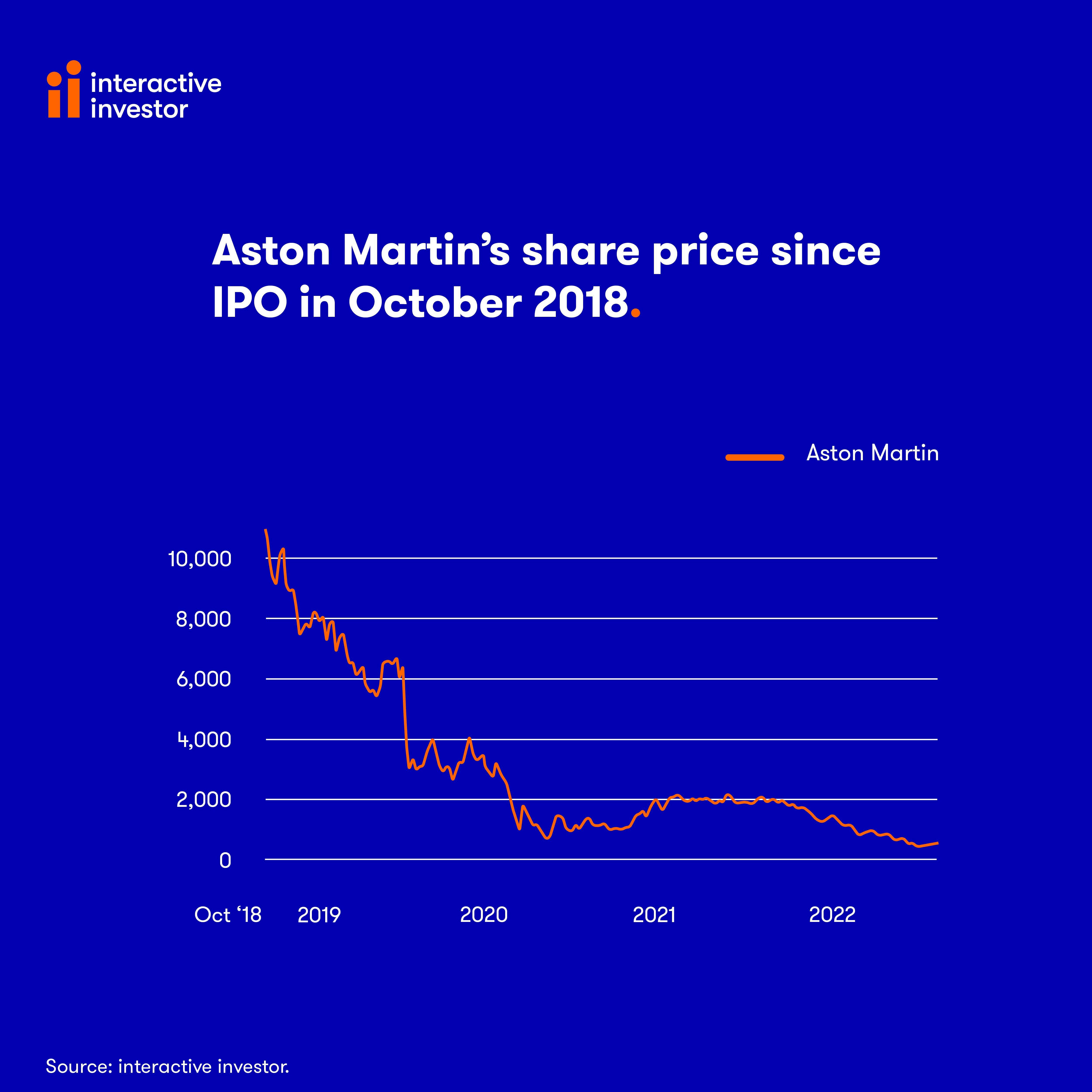Stockwatch: a potential turning point for this global luxury-brand stock
23rd August 2022 13:39
by Edmond Jackson from interactive investor
Companies analyst Edmond Jackson examines the investment case for a stock that’s seen a near-relentless 96% decline after its October 2018 flotation.

This must be classed as a speculative idea, but I think it timely to draw attention to Aston Martin Lagonda Global Holdings (LSE:AML), where a change of top management, a re-capitalisation to ease debt, and strong progress on car development as shown by orders to 2023 sold out, suggest events are potentially coming together.
For a top global brand such as this, dialling into demand from the super-rich who are largely immune from recession, I think such discretionary spending is more likely to hold up than, say, on restaurants or home interiors, as inflation bites.
- Read about how to: Open a Trading Account | How to start Trading Stocks | Top UK shares
If Aston gets its product pitch right – and there is a sign this week that it is spot-on – compulsive buying by the global rich could start to single it out. That is presumably also the rationale why two new major investors – chiefly, Saudi Arabia’s sovereign wealth fund taking a 17% stake – and existing shareholder Mercedes-Benz (XETRA:MBG), are putting £335 million into a £653 million equity re-capitalisation.
Financial record is nowhere near ‘investment grade’
Only the top-line revenue trend offers any encouragement, as the table below shows:
Aston Martin Lagonda Global Holdings
Year-end 31 Dec
| 2016 | 2017 | 2018 | 2019 | 2020 | 2021 | |
| Turnover (£ million) | 593 | 876 | 1,097 | 981 | 612 | 1,095 |
| Operating margin (%) | -5.5 | 17.0 | 2.4 | -5.3 | -56.6 | -3.9 |
| Operating profit (£m) | -32.3 | 149 | 26.0 | -52.0 | -346 | -42.4 |
| Net profit (£m) | -148 | 76.4 | -62.7 | -126 | -419 | -192 |
| EPS - reported (p) | -414 | 214 | -199 | -291 | -541 | -181 |
| EPS - normalised (p) | -325 | 152 | 49.6 | -176 | -342 | -215 |
| Operating cashflow/share (p) | 460 | 962 | 707 | 44.6 | -257 | 155 |
| Capital expenditure/share (p) | 539 | 823 | 986 | 713 | 338 | 160 |
| Free cashflow/share (p) | -79.0 | 139 | -279 | -669 | -595 | -5.0 |
| Return on total capital (%) | -3.6 | 13.5 | 2.1 | -3.9 | -17.4 | -2.2 |
| Cash (£m) | 102 | 175 | 145 | 80.1 | 464 | 393 |
| Net debt (£m) | 618 | 684 | 676 | 985 | 724 | 899 |
| Net assets (£m) | 67.7 | 129 | 424 | 318 | 788 | 642 |
| Net assets per share (p) | 189 | 359 | 1,193 | 897 | 685 | 551 |
Source: historic company REFS and company accounts
Be aware that the six-year financial summary shows a company well away from showing a respectable net profit. The outlier of a profit of £76 million in 2017 was the year before it floated. Consensus expects net losses near £300 million in respect of this year, easing to just over £100 million in 2023.
Last June’s balance sheet had just over £1.1 billion net debt relative to £378 million net assets – of which nearly £1.4 billion constituted intangibles. Most certainly, an intangible value exists for the Aston Martin Lagonda brand, but effectively it was a dire balance sheet – hence the equity-raise, due for shareholders’ approval in early September.
- Stockwatch: Michael Burry has sold all but one stock - should you own it too?
- Stockwatch: a high-flying growth stock plunges, is it time to buy?
Given a 335p price has been set for the placing element of this equity raise, it seems likely the rights issue element will be same – hence potentially scope to average into this stock, lower than 460p in the market currently.
The equity-raise will still leave Aston financially risky in a rising interest rate environment. Up to half the proceeds will be applied to cut debt, albeit only achieving a net debt to equity ratio of 100% to 150% by 2024-25. In the first half of 2022, the net interest cost was £220 million additional to a £73 million operating loss. Yet the board rejected a £1.3 billion equity injection proposal, saying its own assessment of need was fair.
They target £2 billion revenue and £500 million adjusted EBITDA by 2024-25, although mind high levels of capital expenditure and depreciation for vehicle manufacturers, likely to mean real profit much lower than this. Positive free cash flow is, however, also targeted by then.
Stock chart conveys a relentlessly falling knife
An adage says: “stocks that fall over 90% do not come back”, although just possibly you recall WPP (LSE:WPP). The advertising and marketing firm was as low as 2p around the 1992 sterling crisis. The shares are now worth 772p.
Aston’s chart is the worst of any I can recall: a near-relentless 96% decline after its October 2018 flotation. It only appeared to double from late 2020 to mid-2021, due to the over-powering wider rally linked to Covid vaccines appearing.

Past performance is not a guide to future performance.
Investors should wait for a genuine break-out – according to efficient market theory, to affirm that both fundamentals and sentiment have changed.
Former CEO of Ferrari takes up this role at Aston
Amedeo Felisa, the new CEO,has already been a non-executive director of Aston, so therefore should understand the group well. He spent eight years stewarding Ferrari (MTA:RACE) through a turnaround and growth phase - exactly what is required here.
Felisa’s objectives are to achieve a new organisational structure, enhancing the technical team towards a new phase of growth and development – including electrification.
A chief technical officer (CTO) has also joined, who is considered the creator of Ferrari’s first hybrid super-car – besides some of its most iconic models. More recently, he implemented electrification technologies at BMW.
They follow a new chief financial officer (CFO) last May, who was previously CFO for Williams Grand Prix Holdings after 16 years in various senior financial roles at British American Tobacco.
It ought to mean that a new management can reasonably be trusted with their essential message at the end-July interims – how supply chain issues set to ease, while demand remains strong – witness interim revenue up 9% to £542 million. Obviously, a global recession and/or new Covid wave could yet compromise the supply of parts.
New models are set to power further revenue advances
During the first half-year, the DBX707 launched – the world’s most powerful SUV – helping the DBX range’ order intake up 40% like-for-like. A new V12 Vantage was also announced, with all 333 units sold out in March.
In recent days, Aston has unveiled an exclusive new DBR22 (pictured below), a mere two-seater sports car albeit with a 5.2 litre V12 petrol engine, that will horrify environmentalists but may help explain why Saudi money is backing innovation here.
The design harks back to the 1950s DBR1 open-cockpit racing car and is meant to be a last hurrah to the internal combustion engine – at a price of £1.5 million before taxes, higher than the Ferrari Monza and McLaren Elva.
Egregious though it may appear in an energy crisis, the DBR22 is highly assertive for Aston’s reputation in luxury cars - a segment that may prove resilient whatever happens to the global economy. Rising prices can even stimulate demand as status symbols.
We can expect more powerful hybrid and in due course electric cars, as battery technology evolves.

The short interest is around 4% and rising
Turning bullish on this stock means I overlook another indicator that would usually stall me.
Four institutions are over the 0.5% of issued equity capital, disclosure level. Gladstone Capital Management crept up 0.07% to 1.33% last November and last June, Franklin Templeton – generally regarded as a conservative institution – rose 0.10% to 0.6%, while BlackRock edged up 0.09% to 1.22%. Parvus Asset Management, however, cut its short 0.35% to 0.81% in July.
Therefore, several professional investors think this stock is likely to continue falling.
Saudi money effectively underwrites Aston, going forwards
The worse-case scenario looks like a global recession disproving my hunch, Aston sales can flourish. In a few years’ time, debt has continued to weigh on the company such that (additional) powerful investors de-list the company.
Yet that would damage the brand and take a sovereign wealth fund beyond its likely preferred remit. Implicitly, the Saudis think Aston’s development plan is viable; they may also reckon on future scope to add stock if one or more private placements are required.
The nub for buying now is whether you think Aston can issue broadly “in line” updates, going forward. In which scenario, I think the stock can at least build a support level, even rise from a near £550 million value currently. Meanwhile, on the NYSE, Ferrari NV (NYSE:RACE) is valued near £32 billion equivalent. Wait for further evidence as you prefer; my broad stance tilts to: Buy.
Edmond Jackson is a freelance contributor and not a direct employee of interactive investor.
These articles are provided for information purposes only. Occasionally, an opinion about whether to buy or sell a specific investment may be provided by third parties. The content is not intended to be a personal recommendation to buy or sell any financial instrument or product, or to adopt any investment strategy as it is not provided based on an assessment of your investing knowledge and experience, your financial situation or your investment objectives. The value of your investments, and the income derived from them, may go down as well as up. You may not get back all the money that you invest. The investments referred to in this article may not be suitable for all investors, and if in doubt, an investor should seek advice from a qualified investment adviser.
Full performance can be found on the company or index summary page on the interactive investor website. Simply click on the company's or index name highlighted in the article.
Disclosure
We use a combination of fundamental and technical analysis in forming our view as to the valuation and prospects of an investment. Where relevant we have set out those particular matters we think are important in the above article, but further detail can be found here.
Please note that our article on this investment should not be considered to be a regular publication.
Details of all recommendations issued by ii during the previous 12-month period can be found here.
ii adheres to a strict code of conduct. Contributors may hold shares or have other interests in companies included in these portfolios, which could create a conflict of interests. Contributors intending to write about any financial instruments in which they have an interest are required to disclose such interest to ii and in the article itself. ii will at all times consider whether such interest impairs the objectivity of the recommendation.
In addition, individuals involved in the production of investment articles are subject to a personal account dealing restriction, which prevents them from placing a transaction in the specified instrument(s) for a period before and for five working days after such publication. This is to avoid personal interests conflicting with the interests of the recipients of those investment articles.